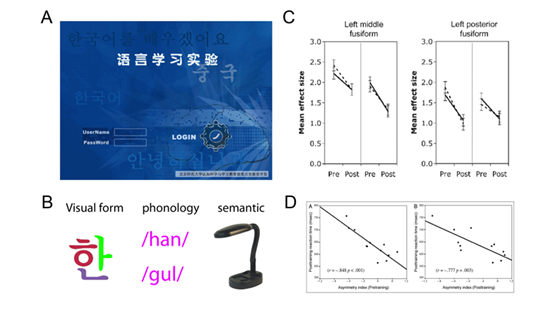In addition to understanding the common mechanisms underlying the learning of different materials, works have also been done to examine the mechanisms that unique to language learning. In particular, we have designed an artificial language that can facilitate the comparison between logographic (e.g., Chinese) and alphabetic writing systems (e.g., English). Using this artificial language and novel training methods, we have discovered (1) the critical role of the left midfusiform in processing novel scripts (Xue et al., 2006, Neuroimage; Xue & Poldrack, 2007, JOCN; Xue et al., 2008, Neuroimage), (2) the role of phonology instead of visual experience in enhancing VWFA activity (Xue et al., 2006, Neuroimage; Xue & Poldrack, 2007, JOCN). These evidences challenged the visual word form area (VWFA) hypothesis proposed by Cohen and colleagues. (3) We also found that the structure and function of midfusiform are reliable neural indicators of individual’s language learning ability (Mei, Xue et al, 2010, Neuroimage;Xue et al., 2010, Plos One;Xue et al., 2006, JOCN; Chen, Xue et al., 2007, Neuropsychologia;Dong, Mei, Xue et al., 2008, Neuroscience letter;Zhang et al., 2013, Neuroimage).
Currently, we are conducting cross-cultural comparisons to examine the role of prior language experiences in shaping the cognitive and neural strategies when learning a new language, in an effort to discover the special difficulties Chinese speakers have in learning a foreign language, such as English.
The Neural mechanisms of language learning. (A) The software for language training and (B) the artificial language system we designed to simulate the learning of logographic and alphabetic writing systems. (C) Visual word form training reduced the activities in the so called “visual word form area” (VWFA) (Xue et al., 2007, Journal of Cognitive Neuroscience), whereas phonological training enhanced VWFA activity (Xue et al., 2006; NeuroImage, not shown here). (D) The functional asymmetry of midfusiform in processing a novel script predicted individual differences in learning a new writing (Xue et al., 2006, Journal of Cognitive Neuroscience).
